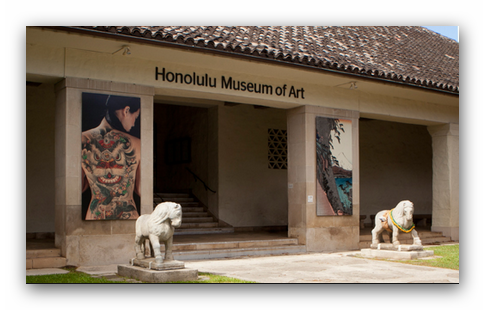Jul 6 2017 - Nov 5 2017
Honolulu, HI
Dragons and tigers are ubiquitous in East Asian art. The two animals have been paired together since distant antiquity, with the earliest example coming from a Neolithic tomb in China, in which the shapes of both creatures were outlined in shells on either side of the deceased. With the development of cosmological theories on the order of the universe, dragon and tiger became associated with the active principle of yang and the passive principle of yin, respectively, and dragons were further related to spring and its life-giving rains, while tigers were connected with autumn and death. Appropriately, the dragon was assigned the color green, symbolic of new growth, and the tiger was assigned the color white, symbolic of the snow that brings the end (death) of the yearly cycle.
With the rise of an imperial government system in China, the dragon became identified with the Emperor, in particular the lofty five-clawed dragon, which often was limited in the arts to items used directly by the ruler. The introduction of Buddhism from South Asia added further nuances, as the Chinese term for dragon (long) was used to translate the South Asian word naga, mythical serpentine water spirits. Naga were capricious, but also connected to the historical Buddha through a story that a naga spread its nine-headed hood over him during a rainstorm. Similarly, dragons in China were auspicious images representing the yang energy of spring, but they could be terrifying, in the same way that a thunderstorm might be welcomed for bringing much needed rain to crops, yet feared for its destructive capacity. This symbolism spread from the Chinese mainland to the Korean peninsula and the Japanese archipelago, where it influenced the development of the arts at the same time that it acquired further culturally distinct nuances.
While the tiger was associated with the yin energy of autumn and death, it could also be a powerful protective symbol. In particular, as Buddhist eremitism developed in East Asia, and stories spread of famous monks who retreated to the mountains to meditate, tigers were often depicted as guardians of these holy figures. This tradition was particularly strong in Korea and Japan, where charming folk stories of tigers added new layers of meaning.
This exhibition draws on rarely shown highlights from HoMA’s permanent collection to illustrate the ways in which dragons and tigers were featured in the arts of China, Korea, and Japan, from exquisite celadon ceramics of the Chinese Song (960–1279) and Korean Goryeo (918–1392) dynasties to paintings and popular ukiyo-e prints of the Edo period (1615–1868) in Japan.
Credit: Exhibition overview from museum website
Exhibition Venues & Dates
Jul 6 2017 - Nov 5 2017
Honolulu, HI
